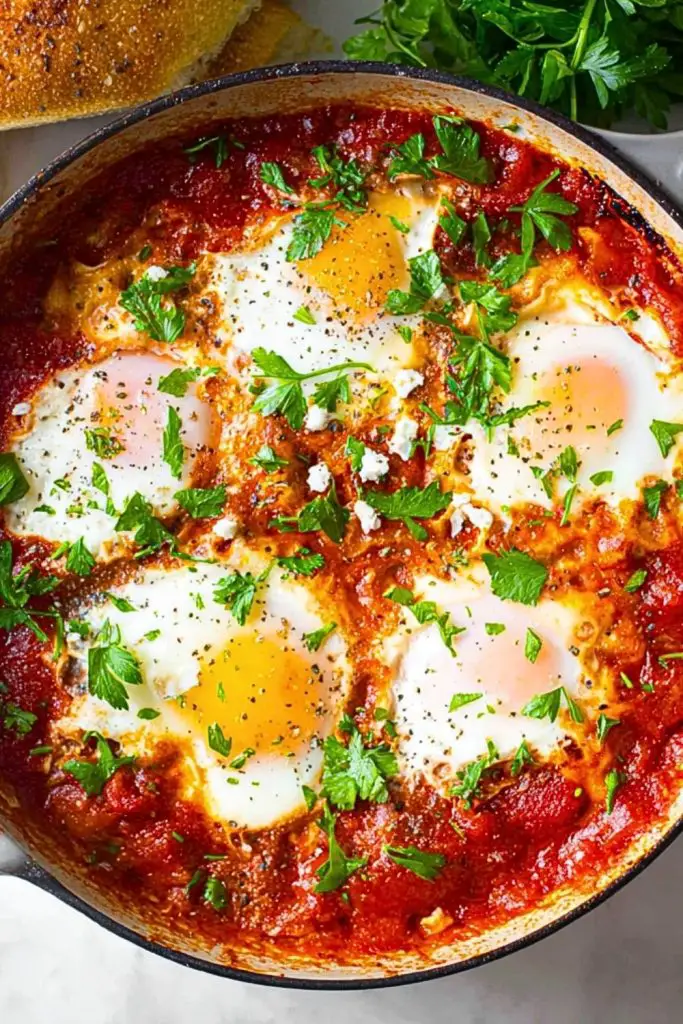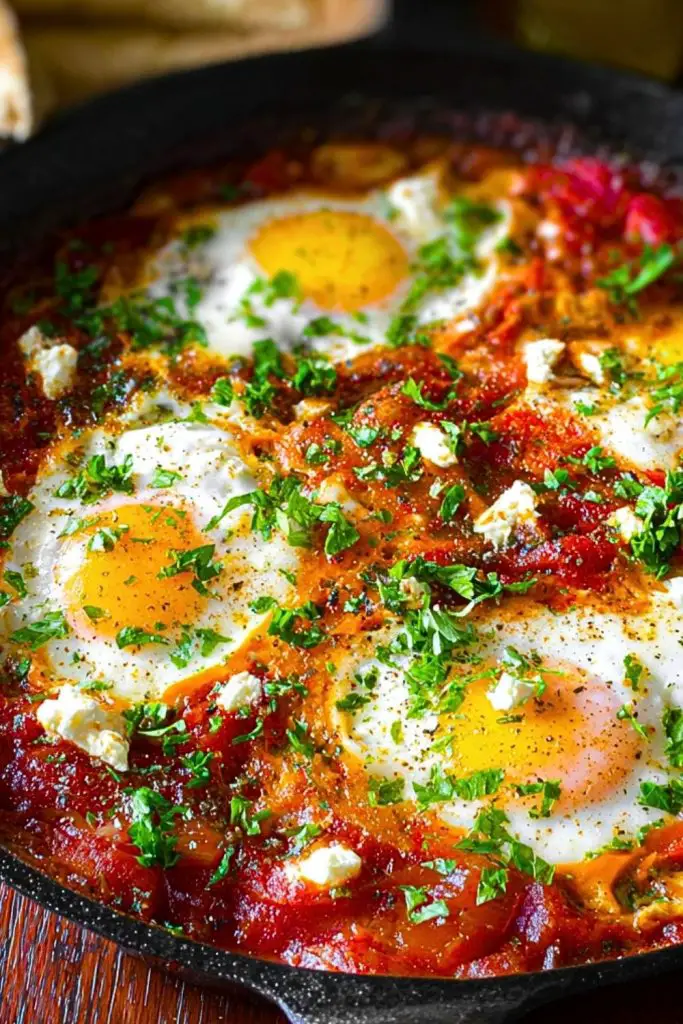I remember the first time I made shakshuka at home—it was early on a lazy Sunday, and I was craving something warm, comforting, and bold. I’d heard of this Middle Eastern classic, but never truly understood the magic until I dipped a piece of toasted bread into that spicy, rich tomato sauce and scooped up a perfectly poached egg. That moment turned shakshuka into a staple in my kitchen.

This recipe has everything I love in a dish: vibrant colors, punchy flavors, and minimal cleanup. It’s also incredibly versatile—you can make it with pantry staples, and it somehow always feels luxurious. Whether I’m cooking for myself or serving brunch to friends, it never fails to impress.
Why You’ll Love This Shakshuka Recipe
This shakshuka recipe is the perfect balance of hearty and healthy. The sauce is rich and deeply flavored with spices, yet it doesn’t feel heavy. The eggs are cooked just until the yolks are soft and silky, making every bite creamy and indulgent.
It’s easy to throw together in one pan, making cleanup a breeze. You don’t need fancy ingredients—just a few basics from your fridge and pantry. Plus, it’s naturally vegetarian and gluten-free, making it a crowd-pleaser for nearly any dietary preference.
What Kind of Tomatoes Should I Use for Shakshuka?
While you can make shakshuka with fresh tomatoes, I’ve found that canned crushed tomatoes work best year-round. They offer consistent flavor and texture, and they reduce into a thick, rich sauce much faster than fresh ones.
That said, if you’ve got a batch of ripe, juicy tomatoes—especially in summer—don’t hold back. Chop them up and let them simmer a bit longer until they break down. For convenience and reliability, though, a good-quality can of crushed or whole peeled tomatoes is my go-to.
Options for Substitutions
One of the reasons I love shakshuka is how flexible it is. If you don’t have one ingredient, there’s almost always a good swap:
- Eggs: You can use egg whites if you’re watching cholesterol, or swap in tofu for a vegan take.
- Feta Cheese: Crumbled goat cheese or even a sprinkle of grated parmesan adds a similar creamy-salty finish.
- Bell Peppers: Not a fan? Use zucchini, mushrooms, or skip them entirely.
- Spices: No cumin? Try coriander or even a pinch of curry powder for a twist.
- Heat Level: Want it milder? Skip the chili flakes. Like it fiery? Add fresh jalapeños or harissa.
Shakshuka is forgiving, so don’t be afraid to make it your own.
Ingredients for This Shakshuka Recipe
- Olive Oil – This forms the base of the dish and helps to sauté the vegetables, adding a rich, fruity note.
- Onion – Essential for building flavor; it softens into sweetness that balances the spice.
- Garlic – Adds depth and an irresistible aroma that infuses the whole sauce.
- Red Bell Pepper – Offers sweetness and a bit of crunch, complementing the acidity of the tomatoes.
- Crushed Tomatoes – The star of the sauce, giving it body, richness, and tang.
- Tomato Paste – Intensifies the tomato flavor and helps thicken the sauce.
- Paprika – Adds a warm smokiness to the base.
- Cumin – Earthy and slightly nutty, it grounds the flavors.
- Chili Flakes – Brings a gentle heat that you can adjust to taste.
- Salt and Black Pepper – Simple, but crucial for balancing and enhancing all the other ingredients.
- Eggs – The centerpiece—soft-poached directly in the sauce for that creamy, runny yolk.
- Feta Cheese – Briny and creamy, it contrasts beautifully with the spicy tomato base.
- Fresh Parsley – A burst of color and freshness right before serving.

Step 1: Sauté the Vegetables
Heat olive oil in a large, deep skillet over medium heat. Add diced onions and cook until soft and translucent, about 5 minutes. Stir in minced garlic and chopped red bell pepper, cooking for another 4–5 minutes until the peppers are just tender.
Step 2: Build the Sauce
Add tomato paste to the pan and stir it in, letting it cook for a minute to deepen the flavor. Then pour in the crushed tomatoes, followed by paprika, cumin, chili flakes, salt, and pepper. Stir everything well and let it simmer gently for 10–15 minutes, uncovered, until the sauce thickens slightly.
Step 3: Add the Eggs
Using the back of a spoon, make small wells in the sauce and carefully crack an egg into each one. Cover the pan with a lid and cook for 5–7 minutes, or until the egg whites are set but the yolks are still soft and runny. Keep an eye on them—you don’t want overcooked yolks!
Step 4: Finish and Garnish
Once the eggs are done to your liking, remove the pan from heat. Crumble feta cheese over the top and sprinkle generously with chopped fresh parsley. Serve immediately with warm crusty bread or pita.
How Long to Cook the Shakshuka Recipe
The total cook time for shakshuka is around 25–30 minutes.
- Sautéing the onions and peppers takes about 8–10 minutes.
- Simmering the sauce will need 10–15 minutes to thicken and develop flavor.
- Cooking the eggs takes another 5–7 minutes depending on how runny or set you like the yolks.
Keep the heat moderate and adjust the timing slightly depending on your stove and skillet depth.
Tips for Perfect Shakshuka
- Use a wide skillet: This allows the eggs to nestle in without crowding, so they cook evenly.
- Don’t rush the sauce: Let it simmer and reduce a bit—it concentrates the flavor.
- Crack the eggs gently: Crack them into a small bowl first, then pour them into the wells to avoid broken yolks.
- Cover to cook eggs: Traps the steam and helps cook the tops without overcooking the bottoms.
- Watch the yolks: As soon as the whites are set and the yolks look glossy, it’s time to remove from heat.
- Adjust seasoning at the end: A final sprinkle of salt and pepper can make all the difference.
Watch Out for These Mistakes While Cooking
- Overcrowding the eggs: Adding too many eggs in a small pan can result in uneven cooking. Stick to 4–6 eggs max depending on pan size.
- Overcooking the yolks: Keep a close eye once the lid goes on—the line between runny and hard-cooked can be just a minute or two.
- Under-seasoning the sauce: Taste before adding the eggs; under-seasoned tomatoes can make the dish feel flat.
- Skipping the simmer: The sauce needs time to thicken; rushing this step leaves it watery and underdeveloped.
- Using low-quality tomatoes: Your sauce is only as good as your tomatoes. Invest in a good-quality canned variety for best results.
What to Serve With Shakshuka?
Crusty Sourdough Bread
Perfect for scooping up the runny yolks and sauce—every bite feels rustic and satisfying.
Warm Pita or Flatbread
Soft and chewy, this traditional pairing is ideal for wrapping around a shakshuka bite.
Herbed Couscous
A fluffy, aromatic grain that absorbs the spiced tomato sauce beautifully.
Fresh Cucumber and Tomato Salad
Adds a crisp, cooling contrast that balances the warm spices in the dish.
Greek Yogurt or Labneh
Creamy, tangy, and cooling—great as a dollop on top or served on the side.
Pickled Vegetables
Tangy pickles or olives cut through the richness of the eggs and feta.
Avocado Slices
The creamy texture complements the warm eggs and spicy sauce.
Mint Tea or Fresh Orange Juice
For a light and refreshing drink to complete your brunch table.
Storage Instructions
Shakshuka is best enjoyed fresh, but leftovers can definitely be saved. Allow the dish to cool to room temperature, then transfer it to an airtight container. It will keep in the fridge for up to 3 days.
To reheat, gently warm it on the stovetop over low heat with a splash of water or tomato sauce to loosen it up. You can also microwave individual portions, though the eggs might become firmer. If you’re planning ahead, it’s best to store the sauce separately and poach fresh eggs just before serving.
Estimated Nutrition
Per serving (based on 1 of 4 servings):
- Calories: ~240
- Protein: 11g
- Fat: 15g
- Saturated Fat: 5g
- Carbohydrates: 14g
- Fiber: 3g
- Sugar: 7g
- Sodium: 580mg
- Cholesterol: 190mg
These numbers can vary depending on your ingredient brands and portion sizes, but this gives a good general idea.
Frequently Asked Questions
Can I make shakshuka ahead of time?
Yes! You can make the tomato sauce in advance and store it in the fridge for up to 3 days. When ready to serve, just reheat the sauce and poach fresh eggs in it.
Can I freeze shakshuka?
You can freeze the tomato base, but not the eggs. Store the sauce in an airtight container for up to 2 months, then defrost and reheat before adding eggs.
What type of pan is best for shakshuka?
A wide, heavy-bottomed skillet like cast iron or a deep sauté pan works best. It distributes heat evenly and allows space for the eggs.
How do I know when the eggs are done?
Look for opaque whites and shiny yolks. Jiggle the pan slightly—if the yolks stay centered and glossy, they’re perfectly runny.
Can I add meat to shakshuka?
Absolutely. Cooked ground lamb, spicy sausage, or even shredded chicken can be added to the tomato base for a heartier version.
Is shakshuka spicy?
It has a gentle heat, but you can easily tone it down or ramp it up by adjusting the chili flakes or adding fresh chili or hot sauce.
Is shakshuka healthy?
Yes—it’s loaded with vegetables, protein from eggs, and healthy fats. It’s naturally gluten-free and vegetarian, making it a well-rounded, nutritious meal.
Can I make it vegan?
Yes. Skip the eggs and feta, and try adding chickpeas or tofu for protein. Let the sauce simmer a little longer until thick and rich.
Conclusion
Shakshuka is more than just a pretty brunch plate—it’s a celebration of bold flavor, simple ingredients, and cozy comfort. Whether you’re new to it or it’s already a favorite, this recipe brings it all together in one skillet.
It’s vibrant, soul-warming, and endlessly adaptable. Try it once, and I promise you’ll want to keep this in your back pocket for every lazy weekend, quick dinner, or special gathering.

The Best Shakshuka Recipe Ever
- Total Time: 30 minutes
- Yield: 4 servings
- Diet: Vegetarian
Description
This shakshuka recipe is a rich, spiced tomato and pepper stew topped with soft-poached eggs and creamy feta. It’s comforting, vibrant, and comes together in just one pan—perfect for breakfast, brunch, or dinner.
Ingredients
2 tbsp olive oil
1 medium onion, diced
3 cloves garlic, minced
1 red bell pepper, chopped
1 tbsp tomato paste
1 can (14 oz) crushed tomatoes
1 tsp paprika
1 tsp ground cumin
1/4 tsp chili flakes (optional)
1/2 tsp salt
1/4 tsp black pepper
4 large eggs
1/3 cup crumbled feta cheese
2 tbsp chopped fresh parsley
Instructions
1. Heat olive oil in a skillet over medium heat. Add diced onion and cook for 5 minutes until soft.
2. Stir in garlic and red bell pepper. Cook another 4–5 minutes until peppers begin to soften.
3. Add tomato paste and stir for 1 minute. Pour in crushed tomatoes and stir in paprika, cumin, chili flakes, salt, and pepper.
4. Simmer uncovered for 10–15 minutes until the sauce thickens slightly.
5. Make small wells in the sauce and crack an egg into each. Cover the pan and cook 5–7 minutes until egg whites are set.
6. Remove from heat, sprinkle with feta and parsley, and serve with bread or your favorite sides.
Notes
Prep Time: 10 minutes
Cook Time: 20 minutes
Total Time: 30 minutes
Yield: 4 servings
Category: Breakfast, Brunch, Main
Method: Stovetop
Cuisine: Middle Eastern
Keywords: shakshuka, eggs in tomato sauce, one-pan brunch, healthy vegetarian
Serving Size: 1 of 4
Calories: 240
Sugar: 7g
Sodium: 580mg
Fat: 15g
Saturated Fat: 5g
Unsaturated Fat: 8g
Trans Fat: 0g
Cholesterol: 190mg
Carbohydrates: 14g
Fiber: 3g
Protein: 11g
- Prep Time: 10 minutes
- Cook Time: 20 minutes
- Category: Breakfast, Brunch, Main
- Method: Stovetop
- Cuisine: Middle Eastern
Nutrition
- Serving Size: 1 of 4
- Calories: 240
- Sugar: 7g
- Sodium: 580mg
- Fat: 15g
- Saturated Fat: 5g
- Unsaturated Fat: 8g
- Trans Fat: 0g
- Carbohydrates: 14g
- Fiber: 3g
- Protein: 11g
- Cholesterol: 190mg
Keywords: shakshuka, eggs in tomato sauce, one-pan brunch, healthy vegetarian

